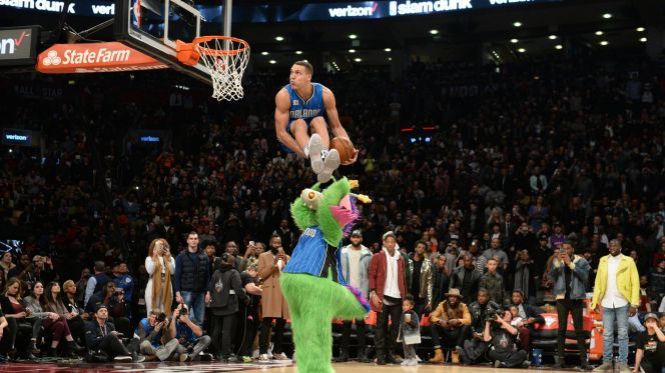
Aaron Gordon, sitting in mid-air Saturday night. Dunks like this deserve more than a 50. (Photo: Yardbarker)
I work a very busy schedule, with 40 hours a week spent at my job, and yet this week I managed to set aside enough time to watch highlights of perhaps the best duel in NBA Dunk Contest history at least 10 times. The same Youtube clip of the eye-popping battle between Minnesota Timberwolves’ Zach LaVine and Orlando Magic’s Aaron Gordon that took place six days ago, over and over again, never managing to get old. It was sports entertainment at its finest–the peak of entertainment in general. The dunk contest over the years has wavered from amazing, to okay, to boring, in a torturous circle of inconsistency. And yet, with these two guys flying through the air, Saturday night’s masterpiece showed that it’s back and here to stay.
Though this is the case, there’s a minor tweak the NBA needs to make in order for the contest to be even more exciting: extend the scoring beyond a 50. LaVine and Gordon combined to throw down six straight 50s, spread over the initial round and championship round, but some were better than others. And while it would’ve been amazing to see 50s handed out and the dunking to go into the morning’s wee hours, alterations must be made so the participants receive the scores they deserve. How can this be accomplished?
First, for the championship round, tack on a possible bonus points for creativity. Take Gordon’s first dunk of the championship round, for instance, with the mascot rotating on a hoverboard, holding the ball outright as the high-flying 20-year-old snatched it, spun 360 degrees, cupping the ball in the process, and slamming it through. The dunk itself was a 50, but additional points would be possible for the mascot’s role and the chemistry between the two in regards to timing it perfectly. Each of the five judges would have a bonus point at their disposal. Perhaps not all of the judges would choose to tack it on, but the odds are at least one out of five would. That way not only Gordon’s dunking ability would get the score it deserved, but also his creativity.
LaVine’s dunks were magnificent. All of them made me shake my head in disbelief and rightfully brought those in attendance in Toronto out of their seats. While Gordon is more taller and more muscular and thus appearing more powerful , LaVine’s slender build makes it look as if he’s soaring through the air. It’s a sight to behold, a thing of beauty. And yet the scores he received showed why the scoring system is flawed. As an example, for his dunk attempt that followed Gordon’s 360, he copied it, except without a mascot or teammate or Gordon’s additional flair of putting his available hand behind his head. LaVine bounced the ball to himself instead. As TNT analyst Kenny Smith said, “Even though Aaron’s was better, that’s a fifty.” Within the system that is in place now, almost mirroring a “50” is deemed just as good. Therein lies the problem. Was it a 50? Yes. Did it have all of the pizazz of Gordon’s? No. Hence the dunk is a 50, but under the suggested rule there’s a chance he would be behind because of his lack of creativity. There is no way LaVine spent time conceiving that style of dunk only for Gordon to happen to do the same thing right before. Gordon clearly spent time with the mascot to work on his slam. If the suggested rule change was implemented, Gordon might receive a 52 to LaVine’s 50.
Another wrinkle could be added to spice things up and test the imagination of the dunkers, and that’s cutting down on the similarities in dunks by a contestant. During the championship round, LaVine dunked from a foot inside the free-throw line twice. It was an incredible feat, as the first was a windmill and second between-the-legs, but lacked originality. He had also dunked from the same spot in the opening round, and while it was wowing watch him glide through the air on all three occasions it was clear he had little up his sleeve. Okay, we get it, you can dunk leaping from far away, just not actually the free-throw line.
All three of those dunks were 50s, according to the judges, and on their own, yes, that’s accurate. Yet, in a contest that looks to feature ability and creativity there really isn’t a place for this repetitiveness. And so, a new rule: if a contestant attempts a dunk that is similar in origin to another in that round–whether it be a windmill, between-the-legs, 360 or from the free-throw line–it cannot be a 50.
In contrast to LaVine Gordon had four dunks in the championship round that were original: the aforementioned, his second that brought the house down–an under-the-legs jam that can’t properly be described in words, only seen–a windmill along the baseline on a pass off the backboard’s side from teammate Elfrid Payton, and a thunderous Dominique Wilkins-esque reverse slam. Everything but the latter received a 50, and deservedly so. Each was unique, with its own backbone. There was no duplication of ideas.
If these rules were implemented, Gordon would’ve won. After LaVine essentially mirrored Gordon’s 360, TNT analyst Charles Barkley proclaimed that the trophy would head to Orlando. He was going by the logic that originality should matter. Simply based off the reaction of the fans, analysts and judges, Gordon’s under-the-legs slam (pictured above) generated the most buzz. How could it not? He took a seat in mid-air, with a person underneath him. This created that reaction because it’s something never been done before in the dunk contest. That kind of thinking warrants a trophy, but for this to take place changes need to be made, or the best of the best dunks won’t truly stand out.